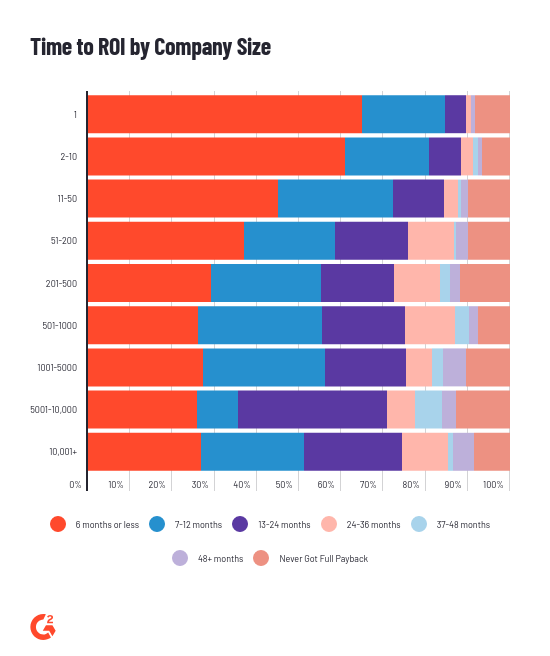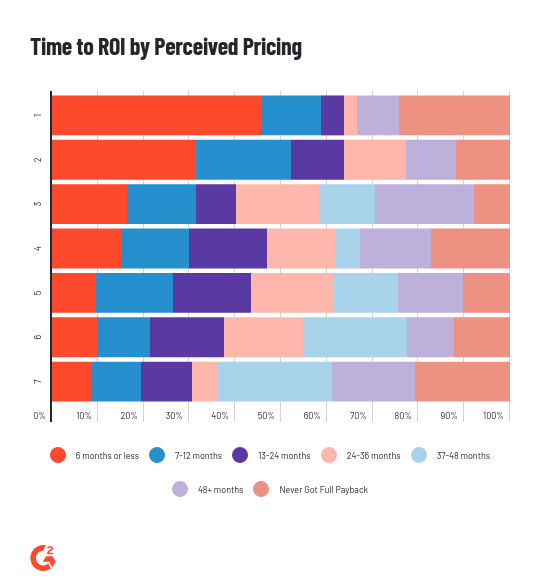Return on investment (ROI): one of the most important factors in software purchase decision making, yet one of the hardest to measure. So you invest in an expensive, fully integrated CRM system; sales skyrocket that year. Is one linked to the other? And if so, how much of the success can be attributed to the CRM system? How can we know with certainty that our investment paid off?
What G2 review data reveals about web content management software
G2 reviews provide us with buyers’ experiences with software solutions—their thoughts on ease of use, customer service, onboarding, price, likelihood to recommend the software solution, and so on. Individually, the answers to these questions are interesting, especially to the sellers of these products. However, when the review data from thousands of reviews across various industries and business segments is sliced and diced, we get rich stories of the wider software landscape.
Here are some key takeaways from G2’s ROI data for web content management software.
Time to ROI by company size

The chart above compares what G2 reviewers stated the time to ROI was on their web content management software investments to their company size. Each vertical bar is broken up in the percentages of responses of each “time to ROI” time period for a given employee count.
A couple of observations can be made from this chart. There is an inverse correlation between the company size and a time to ROI that is six months or less. In other words, the smaller the company, the more likely a reviewer was to state that the time to ROI on their software investment was six months or less. Likewise, as the company size increases, so does the time to ROI. This isn’t a completely linear relationship. However, the larger the employee count, the more likely a reviewer was to state a long time to ROI.
It can be inferred that there are characteristics of larger companies that cause a longer time to reach ROI. One such characteristic is the ease of set up and onboarding, both of which are more difficult with more employees. The longer it takes to start implementing a software solution effectively, the longer it takes to see the revenue and profit implications of the software. Another is subscription costs per user. Many software providers will charge fees per additional user, making costs dramatically increase. As costs go up, the longer it takes to realize the positive implications.
Time to ROI by G2 star rating

The chart above shows the time to ROI for web content management software compared with the star rating given to the products. Star ratings are given by reviewers when they review products on G2. They are asked to rank their satisfaction with the product on a scale from 1-10, and that score is then halved to produce the star rating.
The strongest correlations that can be seen are for reviewers that indicated a time to ROI that was six months or less or never got a full payback. The highest percentage of 5-star reviews stated an ROI of six months or less, and as the star rating went down, the percentage of "6 months or less" responses went down, with a few exceptions. A star rating of 0 had the largest percentage of “never got a full payback” responses. As the star ratings increased, the percentage of “never got a full payback” responses decreased, again with a few exceptions.
Of course, there are several factors that play into the star rating a user decides to give a software product. However, it’s easier for a user to give a 5-star rating when they see returns on their investment quickly and for a user to provide a low star rating when they never see a return.
Time to ROI by perceived pricing

This chart above shows time to ROI compared with reviewers’ perceived pricing of web content management software. G2 asks reviewers to rank how expensive they thought a software product was on a scale of 1-7. G2’s pricing question inherently asks reviewers about more than just pricing. Since they are asked to input a scale rating as opposed to an actual number value, they may take into consideration factors such as how expensive this product was compared to other similar products they have used or how beneficial this product was compared to how much they paid for it.
According to these findings, there is a slight correlation between the price of software and the time to ROI. As the price of software increased, the time to ROI also increased. This makes sense because the more expensive an investment, the time it takes to see returns on that investment would be longer.
ROI and the wider software landscape
ROI will always be complicated to calculate, especially as the way we work changes rapidly. However, many of these trends shown by review data for the Web Content Management category on G2 can be transferred to other categories. ROI will usually always be impacted by factors such as company size, star rating and a user’s satisfaction with the software, and pricing.
Möchten Sie mehr über Web-Content-Management-Software erfahren? Erkunden Sie Web-Content-Management Produkte.

Priya Patel
Priya is a Senior Research Analyst at G2 focusing on content management and design software. Priya leverages her background in market research to build subject matter expertise in the software space. Before moving back to Chicago in 2018, Priya lived in New Zealand for several years, where she studied at the University of Auckland and worked in consulting. In her free time, Priya enjoys being creative, whether it’s painting, cooking, or dancing.
